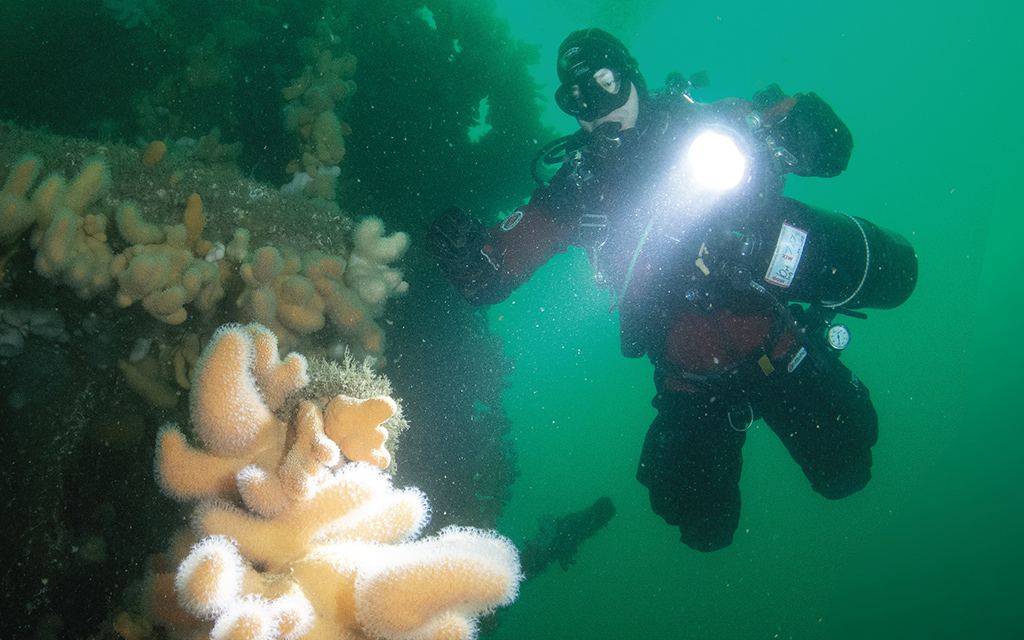
The time-honoured adage to ‘dive the plan’ is crucial when it comes to finding your way across a wreck, says Kirsty Andrews.
Be prepared. My scouting motto, and pretty applicable to scuba too. How much preparation time do you spend? On this occasion I’m not talking about your equipment or your personal diving skills, although I certainly believe those benefit from preparedness pre-dive. I’m thinking of the time put in in advance to gain knowledge of your chosen site.
Personally, I’ve been a bit of a late bloomer when it comes to dive site knowledge. I’d visited Scapa Flow on no less than three separate occasions before I really put much thought into what I was seeing. I’m not proud of that, by the way, but I do cut myself a bit of slack; at first I was relatively new to diving those depths, and my focus (as far as I can remember) was the experience of going that little bit deeper, or getting used to twinset diving, or planning my decompression stops in a rather regimented way, or just having a giggle with my university mates on a holiday trip. All worthwhile endeavours.
I do now try... to do as much research as possible in advance of the dive. I know it will pay dividends in enabling me to navigate and appreciate the site
Don’t get me wrong, I enjoyed the lure of the rusty metal and I had some memorable moments, but there wasn’t a lot of method to it. I still remember fondly my first favourite swim-through on the light cruiser SMS Cöln, which sadly collapsed in on itself some years since. The thrill of being surrounded by wreckage, squidgy dead man’s fingers and juvenile fish on all sides - a longish swim-through, but with an easy obvious exit; penetration for beginners. Not a technically special part of the wreck, but a highlight for me in my formative years.
A few years passed and I dived the Flow from a different boat, with skipper Emily Turton, whose dive briefings are quite rightly legendary. What they are not is brief - you may well spend upwards of half an hour going over the dive plan, covering the history of the wreck and a proposed route for the dive, with the aid of photos, sonar side scans and drawings. I vividly remember diving the battleship Markgraf after one of these briefing sessions and it was an entirely new experience, as if I was seeing and understanding the wreck for the first time. As I navigated the ‘gun run’ past intact portholes towards the famous rudders, I was (quite a rare experience for me even now) following the set route to the letter. I had, if you will, planned the dive and dived the plan.
At this point I must say that I am happy flitting between the dive boats of Scapa; I’ve spent time on most of them and invariably had a lovely experience. They are all quite different and I appreciate each for various reasons. In a crowded field of impressive expertise, Emily does get the gold trophy for briefings though.
Even in the absence of a helpful skipper - and the knowledge amassed by the Orkney collective is formidable - I do now try, on my own account, to do as much research as possible in advance of the dive. I know it will pay dividends in enabling me to navigate and appreciate the site once I’m immersed.
There’s plenty of information available for the enquiring mind. I have an old-school book collection to start with but then there’s helpful websites and even incredibly useful photogrammetry projects in many cases, so you can truly visualise the dive. Thank you to the generous souls who made those available to the masses. We’re lucky to have these resources, to really make the most of our all-too-brief in-water time.
Article ‘Go with the plan’ by Kirsty Andrews first published in SCUBA magazine, Issue 146 June 2024.

 Author: Kirsty Andrews | Posted 02 Jul 2024
Author: Kirsty Andrews | Posted 02 Jul 2024



